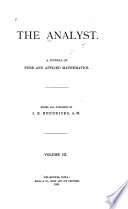 In this regard, the acceleration is directly proportional to the square of the velocity and inversely proportional to the radius of the turn. By common usage, where the axis of rotation is external to the body, as in an aircraft turn or a centrifuge,... In this regard, the acceleration is directly proportional to the square of the velocity and inversely proportional to the radius of the turn. By common usage, where the axis of rotation is external to the body, as in an aircraft turn or a centrifuge,...  General Electric Review - Page 1321907Full view General Electric Review - Page 1321907Full view - About this book
 | Robert Walker - Hydrostatics - 1851 - 230 pages
...velocity with which it revolves, and the radius of the circle, as expressed in the following force is proportional to the square of the velocity, and inversely proportional to the radius-of the circle. It is evident, that the tendency to persevere in a straight line will increase... | |
 | Joseph Allen Galbraith - 1854 - 98 pages
...obtain The centrifugal force, which is equal and opposite to the deflecting force, is therefore directly proportional to the square of the velocity, and inversely proportional to the radius of the circle described. The equation (12) may be put into a more convenient form, in the following... | |
 | Joseph Allen Galbraith, Samuel Haughton - Mechanics - 1866 - 200 pages
...(20) The centrifugal force, which is equal and opposite to the deflecting force, is therefore directly proportional to the square of the velocity, and inversely proportional to the radius of the circle described. The equation (20) may be put into a more convenient form, in the following... | |
 | William James Browne - 1872 - 146 pages
...centripetal force, and is therefore equal and opposite to it. Hence it is=/ = — . That is, it is directly proportional to the square of the velocity, and inversely proportional to the radius of the circle. This gives the centrifugal force of the unit of mass. On any mass m the centrifugal... | |
 | J Alfred Skertchly - 1873 - 184 pages
...is, therefore, equal and opposite to the deflecting or centripetal force, and consequently directly proportional to the square of the velocity, and inversely proportional to the radius of the circle described. In other words, the centrifugal force may be found by multiplying the... | |
 | Electronic journals - 1882 - 452 pages
...by a constant force directed to that center, will develop a centrifugal force which will be directly proportional to the square of the velocity and inversely proportional to the radius of the circle. If we put R for the earth's equatorial radius and V for its equatorial velocity... | |
 | W. G. Willson - Dynamics - 1874 - 294 pages
...is, at any instant, directed towards the centre of the circle ; it is constant in amount ; directly proportional to the square of the velocity, and inversely proportional to the radius of the circle. Cor. — When the angular velocity is given, we have (Art. 10) a = no2. When... | |
 | Mathematics - 1881 - 608 pages
...by a constant force directed to that center, will develop a centrifugal force which will be directly proportional to the square of the velocity and inversely proportional to the radius of the circle. If we put R ibr the earth's equatorial radius and V for ita equatorial velocity... | |
 | William James Browne - Mechanics - 1883 - 218 pages
...equal and opposite to it ; ie, it acts from the centre, and is = F = = 4W -=j. Hence it is directly proportional to the square of the velocity, and inversely proportional to the radius of the circle; or, it is directly proportional to the radius, and inversely proportional to... | |
 | Stephen Roper - Electric engineering - 1899 - 408 pages
...pipe the less the lost pressure. The loss of pressure is proportional to the length of the pipe and the square of the velocity, and inversely proportional to the diameter of the pipe.* Q. Having these tables, how would you calculate the velocity at which water escapes from a pipe 500... | |
| |